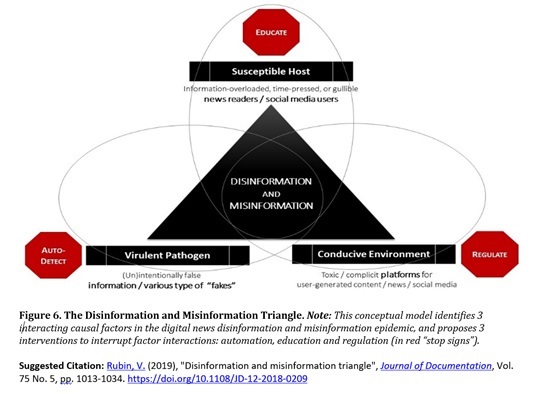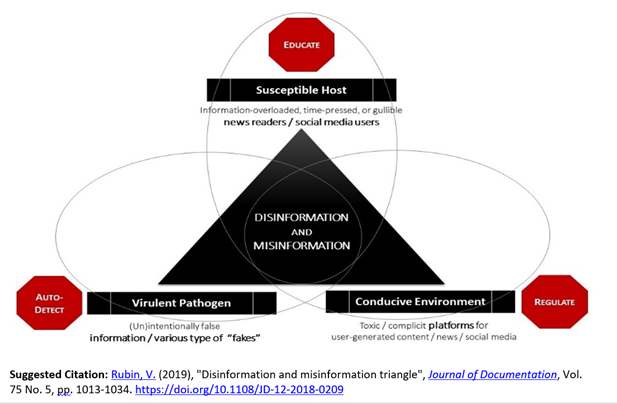 The Disinformation and misinformation triangle (Rubin, 2019) is a conceptual model for ‘fake news’ epidemic, causal factors and interventions.
The Disinformation and misinformation triangle (Rubin, 2019) is a conceptual model for ‘fake news’ epidemic, causal factors and interventions.
Author’s Keywords: disinformation, misinformation, deception; Internet, newspapers, fake news; machine learning, natural language processing; automated deception detection, automated satire detection, automated clickbait detection.
Suggested citation: Rubin, V. (2019), “Disinformation and misinformation triangle”, Journal of Documentation, Vol. 75 No. 5, pp. 1013-1034. https://doi.org/10.1108/JD-12-2018-0209
Abstract: Purpose
This position paper treats disinformation and misinformation (intentionally deceptive and unintentionally inaccurate misleading information, respectively) as a socio-cultural technology-enabled epidemic in digital news, propagated via social media.
Design/methodology/approach
The proposed Disinformation and Misinformation Triangle is a conceptual model that identifies the three minimal causal factors occurring simultaneously to facilitate the spread of the epidemic at the societal level.
Findings
Following the epidemiological Disease Triangle model, the three interacting causal factors are translated into the digital news context: (1) the virulent pathogens are falsifications, clickbait, satirical ‘fakes’ and other deceptive or misleading news content; (2) the susceptible hosts are information-overloaded, time-pressed news readers lacking media literacy skills; and (3) the conducive environments are polluted poorly-regulated social media platforms that propagate and encourage the spread of various ‘fakes’.
Originality/value
The three types of interventions – automation, education, and regulation – are proposed as a set of holistic measures to reveal, and potentially control, predict and prevent further proliferation of the epidemic. Partial automated solutions with natural language processing, machine learning and various automated detection techniques are currently available, as exemplified here briefly. Automated solutions assist (but not replace) human judgements about whether news is truthful and credible. Information literacy efforts require further in-depth understanding of the phenomenon and interdisciplinary collaboration outside of the traditional library and information science, incorporating media studies, journalism, interpersonal psychology and communication perspectives.
